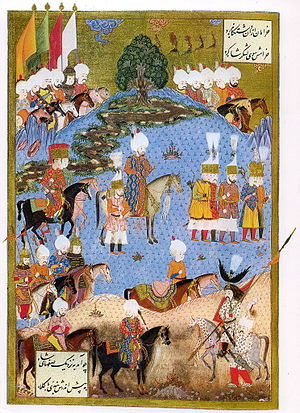- Ottoman–Safavid War (1532–1555)
-
Ottoman-Safavid War of 1532–1555 Part of the Ottoman–Persian Wars 
Miniature depicting Suleiman marching with an army in Nakhchivan, summer 1554, at the end of the Ottoman-Safavid War.Date 1532-1555 Location Iraq, Armenia, Persia Result Peace of Amasya Territorial
changesOttomans capture Baghdad , lower Mesopotamia , the mouths of the Euphrates and Tigris, and part of the Persian Gulf coast. Belligerents  Safavid Empire
Safavid Empire Ottoman Empire
Ottoman EmpireCommanders and leaders  Tahmasp I
Tahmasp I Suleiman the Magnificent
Suleiman the MagnificentStrength 200,000 men
300 pieces of artilleryOttoman–Safavid Wars
Chaldiran – War of 1532–1555 – War of 1578–1590 – War of 1603–1618 – War of 1623–1639 – War of 1722–1727
Campaigns of Nader Shah
War of 1730–1736 – War of 1743–1746
Subsequent conflicts
War of 1821–1823The Ottoman–Safavid War of 1532–1555 was fought between the Ottoman Empire of Suleiman the Magnificent and the Persian Safavid Empire of Tahmasp I.
Contents
Background
The war was triggered by territorial disputes between the two empires, especially when the Bey of Bitlis decided to put himself under Persian protection.[1] Also, Tahmasp had the governor of Baghdad, a sympathiser of Suleiman, assassinated.
On the diplomatic front, Persia had been engaged in discussions with the Habsburgs for the formation of a Habsburg-Persian alliance that would attack the Ottoman Empire on two fronts.[1]
Campaign of the Two Iraqs (First campaign, 1532–1534)
The Ottomans, first under the Grand Vizier Ibrahim Pasha, and later joined by Suleiman himself, successfully attacked Safavid Iraq, recaptured Bitlis, and proceeded to capture Tabriz and then Baghdad in 1534.[1] Tahmasp remained elusive as he kept retreating ahead of the Ottoman troops, adopting a scorched earth strategy.
Second campaign (1548–1549)
Attempting to defeat the Shah once and for all, Suleiman embarked upon a second campaign in 1548–1549. Again, Tahmasp adopted a scorched earth policy, laying waste to Armenia. Meanwhile, the French king Francis I, enemy of the Habsburgs, and Suleiman the Magnificent were moving forward with a Franco-Ottoman alliance, formalized in 1536, that would counter-balance the Habsburg threat. In 1547, when Suleiman attacked Persia, France sent its ambassador Gabriel de Luetz, to accompany him in his campaign.[2] Gabriel de Luetz gave military advice to Suleiman, as when he advised on artillery placement during the Siege of Van.[2] Suleiman made gains in Tabriz and Iranian conquered Armenia, secured a lasting presence in the province of Van, and took some forts in Georgia.
Third campaign (1553–1555)
In 1553 Suleiman began his third and final campaign against the Shah, in which he first lost and then regained Erzurum. Ottoman territorial gains were secured by the Peace of Amasya in 1555. Suleiman returned Tabriz, but kept Baghdad, lower Mesopotamia, the mouths of the Euphrates and Tigris, and part of the Persian Gulf coast.
Due to his heavy commitment in Persia, Suleiman was only able to send limited naval support to France in the Franco-Ottoman Invasion of Corsica (1553).
Notes
-
The walled city of Van, which Gabriel de Luetz d'Aramon helped conquer.
Categories:- 16th-century conflicts
- Ottoman–Persian Wars
- 16th century in Asia
- Suleiman the Magnificent
- History of Georgia (country)
Wikimedia Foundation. 2010.


